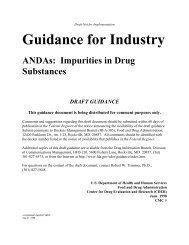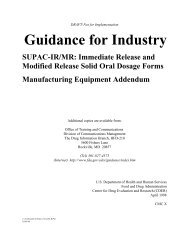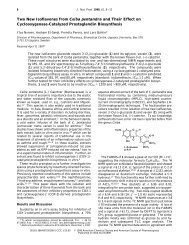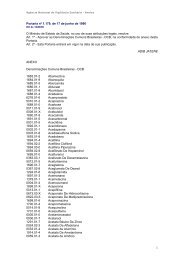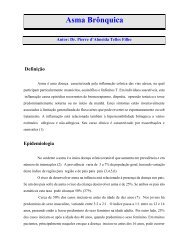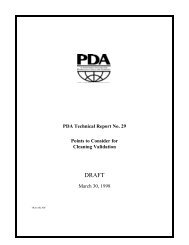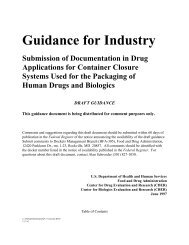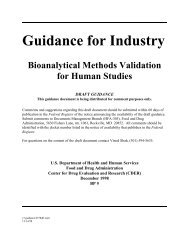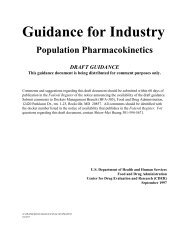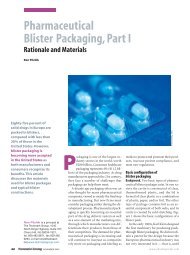Microbial Biotransformation of Veratramine - American Chemical ...
Microbial Biotransformation of Veratramine - American Chemical ...
Microbial Biotransformation of Veratramine - American Chemical ...
Create successful ePaper yourself
Turn your PDF publications into a flip-book with our unique Google optimized e-Paper software.
J. Nat. Prod. 1998, 61, 149-151<br />
149<br />
<strong>Microbial</strong> <strong>Biotransformation</strong> <strong>of</strong> <strong>Veratramine</strong><br />
Khalid A. El Sayed*<br />
Department <strong>of</strong> Pharmacognosy, School <strong>of</strong> Pharmacy, University <strong>of</strong> Mississippi, University, Mississippi 38677<br />
Received July 29, 1997<br />
Preparative-scale fermentation <strong>of</strong> the known C-nor-D-homosteroidal alkaloid veratramine (1)<br />
with Nocardia species ATCC 21145 has resulted in the isolation <strong>of</strong> three new metabolites,<br />
2-4. The structure elucidation <strong>of</strong> these compounds was conducted primarily by 2D NMR<br />
analysis. The microbe Nocardia species ATCC 21145 was able to metabolize rings A and B <strong>of</strong><br />
veratramine but failed to metabolize its nitrogen-containing side chain, an observation<br />
consistent with previous fermentation studies on steroidal alkaloids.<br />
Veratrum alkaloids represent a group <strong>of</strong> potent hypotensive<br />
agents that lower blood pressure by reflex<br />
suppression <strong>of</strong> the cardiovascular system. 1 <strong>Veratramine</strong><br />
(1) is a known veratranine C-nor-D-homosteroidal<br />
Veratrum alkaloid. 2 It antagonizes the Na + channelgating<br />
mechanism <strong>of</strong> ceveratrum alkaloids by blocking<br />
the Na + channels. 3 <strong>Veratramine</strong> also shows serotonin<br />
(5-HT) agonist activity, acting on presynaptic 5-HT<br />
neurons. The administration <strong>of</strong> vertatramine induces<br />
generalized tremors, myoclonus, hindlimb abduction,<br />
backward gait, and Straub tail, similar to the 5-HT<br />
syndrome in mice. 4 Recently, 1 was reported to induce<br />
hemolysis <strong>of</strong> human red blood cells. 5<br />
Metabolism studies have been used successfully as<br />
model systems to predict metabolic pathways in humans<br />
or to increase the efficacy <strong>of</strong> drugs by metabolic activation.<br />
Microorganisms have recently been used as in<br />
vitro models for predicting mammalian drug metabolism.<br />
6 Steroidal alkaloids have been investigated in<br />
metabolism studies due to their interesting biological<br />
activities. 7 Tomatidine is a known spirosolane-type<br />
Solanum alkaloid with the commonly encountered sixmembered<br />
C-ring and five-membered D-ring steroidal<br />
skeleton. Incubation with Nocardia restrictus, Mycobacterium<br />
phlei, and Gymnoascus reesii resulted in the<br />
metabolism <strong>of</strong> tomatidine to 1,4-tomatidien-3-one, tomatidone,<br />
tomatanin-3R-ol, 1-tomatiden-3-one, and 4-tomatiden-3-one<br />
but failed to induce any N-containing sidechain<br />
modification. 7,8 The only previous attempt to<br />
study the microbial metabolism <strong>of</strong> a C-nor-D-homosteroidal<br />
alkaloid enabled the conversion <strong>of</strong> jervine into<br />
an unidentified antibacterial product using Piricularia<br />
oryzae. 9 In the present study, veratramine (1) was<br />
chosen for a microbial bioconversion study in an attempt<br />
to prepare less toxic and more bioactive analogues and<br />
to check whether there would be any metabolism in the<br />
N-containing side chain.<br />
Twenty-five growing cultures were screened for their<br />
ability to bioconvert 1. Few were observed to transform<br />
1 completely or partially to metabolites <strong>of</strong> the same or<br />
greater polarity. Nocardia species ATCC 21145 was<br />
chosen for preparative-scale fermentation because it<br />
entirely depleted 1 and converted it into a compound <strong>of</strong><br />
the same polarity, 2, and two more polar ones, 3 and 4.<br />
* To whom correspondence should be addressed. Phone: (601) 232-<br />
7184. FAX: (601) 232-7026. E-mail: elsayed@olemiss.edu.<br />
The FT-IR spectrum <strong>of</strong> 2 showed a strong absorption<br />
band at 1705 cm -1 , indicating the presence <strong>of</strong> a ketone.<br />
The HRFABMS data <strong>of</strong> 2 suggested a molecular formula<br />
<strong>of</strong> C 27 H 39 O 2 N. Comparison <strong>of</strong> the 1 H- and 13 C-NMR<br />
data <strong>of</strong> 2 (Table 1) with those published for 1, 10 suggested<br />
the disappearance <strong>of</strong> the ∆ 5 system and the<br />
hydroxyl group at C-3, and the appearance <strong>of</strong> a new<br />
carbonyl group, which was observed at 211.4 ppm. The<br />
chemical shift value <strong>of</strong> the C-19 methyl group (11.6 ppm)<br />
indicated that the H-5 proton was in the R-orientation. 2<br />
The 13 C-NMR data <strong>of</strong> rings A and B indicated that the<br />
A-B ring junction was trans and further supported<br />
structure 2. 11 Accordingly, metabolite 2 was assigned<br />
as (23R)-12,13,14,15,16,17-hexadehydro-23-hydroxy-5Rveratranin-3-one.<br />
The UV absorption maximum <strong>of</strong> 3 at λ max 263 nm<br />
suggested an R,β-unsaturated ketone system. This was<br />
further supported by the strong absorption band at 1662<br />
cm -1 in the FT-IR spectrum <strong>of</strong> 3. The HRFABMS data<br />
<strong>of</strong> 3 showed a molecular ion peak that was less than<br />
that <strong>of</strong> 2 by only 2 mass units and, hence, suggested<br />
the molecular formula C 27 H 37 O 2 N. The downfield quaternary<br />
carbon resonating at 199.4 ppm was assigned<br />
to the R,β-unsaturated ketone group at C-3. The olefinic<br />
methine carbon resonating at δ 125.2, which correlated<br />
to the proton singlet at δ 5.82, was assigned to C-4 on<br />
the basis <strong>of</strong> the HMBC spectrum. The H-4 signal<br />
showed 3 J-correlations with the methylene carbons C-2<br />
and C-6, resonating at 33.8 and 33.2 ppm, respectively,<br />
as well as with the quaternary carbon C-10 resonating<br />
at 38.4 ppm (Table 1). Proton H-4 showed also a 2 J-<br />
correlation with the ketone carbon C-3. The downfield<br />
quaternary olefinic carbon resonating at 169.9 ppm was<br />
assigned to C-5, which was confirmed by its 3 J-HMBC<br />
correlation with the methyl proton singlet C-19 resonating<br />
at δ 1.30. In light <strong>of</strong> the aforementioned spectral<br />
data, 3 was assigned as the 4,5-didehydro derivative <strong>of</strong><br />
compound 2.<br />
The UV absorption maximum <strong>of</strong> 4 at λ max 292 and<br />
280 nm suggested an R,β-unsaturated ketone system.<br />
The FT-IR spectrum <strong>of</strong> 4 showed a strong absorption<br />
band at 1660 cm -1 , which supported this inference. The<br />
HRFABMS <strong>of</strong> 4 exhibited a molecular ion peak that was<br />
less than that <strong>of</strong> 3 by only 2 mass units and, hence,<br />
suggested a molecular formula <strong>of</strong> C 27 H 35 O 2 N. The<br />
appearance <strong>of</strong> an additional double bond was also<br />
S0163-3864(97)00361-3 CCC: $15.00<br />
© 1998 <strong>American</strong> <strong>Chemical</strong> Society and <strong>American</strong> Society <strong>of</strong> Pharmacognosy<br />
Published on Web 01/23/1998
150 Journal <strong>of</strong> Natural Products, 1998, Vol. 61, No. 1 Notes<br />
Table 1.<br />
13<br />
C- and 1 H-NMR Spectral Data <strong>of</strong> Compounds 2-4 a<br />
2 3 4<br />
position δ C δ H δ C δ H δ C δ H<br />
1 38.4, t 2.49 m, 2.44 m 36.2, t 2.05 m, 1.52 m 155.5, d 7.02 d (9.9)<br />
2 38.0, t 2.35 m, 1.99 m 33.8, t 2.03 m, 1.91m 127.5, d 6.28 dd (10.0, 1.6)<br />
3 211.4, s 199.4, s 186.8, s<br />
4 44.0, t 2.21 m, 2.18 m 125.2, d 5.82 s 125.5, d 6.16 dd (1.5, 1.4)<br />
5 46.5, d 1.61 m 169.9, s 167.5, s<br />
6 28.9, t 2.34 m, 1.51 m 33.2, t 2.56 m, 2.51 m 33.1, t 2.67 m, 2.62 m<br />
7 29.5, t 2.54 m, 1.49 m 29.5, t 2.45 m, 2.40 m 29.8, t 2.76 m, 1.27 m<br />
8 44.1, d 2.89 ddd (11.9, 10.7, 3.6) 43.7, d 3.05 ddd (12.0, 11.6, 3.6) 43.8, d 3.14 ddd (11.8, 11.8, 3.4)<br />
9 60.0, d 1.64 ddd (12.5, 7.0, 4.8) 59.5, d 1.76 m 56.3, d 1.78 ddd (12, 11.8, 6.9)<br />
10 35.6, s 38.4, s 44.0, s<br />
11 30.5, t 2.75 dd (14.5, 6.8) 1.45 m 30.1, t 2.75 dd (14.5, 6.8) 1.45 m 30.7, t 2.85 dd (14.2, 7.0) 1.44 m<br />
12 142.4, s 142.2, s 140.8, s<br />
13 132.7, s 132.9, s 132.9, s<br />
14 143.6, s 142.8, s 141.8, s<br />
15 119.2, d 6.95 d (7.7) 119.4, d 6.98 d (7.7) 119.3, d 6.96 d (7.8)<br />
16 125.2, d 7.22 d (7.7) 125.5, d 7.24 d (7.7) 125.6, d 7.24 d (7.8)<br />
17 140.3, s 140.6, s 141.5, s<br />
18 15.8, q 2.30, s 15.8, q 2.31, s 15.7, q 2.31, s<br />
19 11.6, q 1.13, s 16.8, q 1.30, s 18.7, q 1.34, s<br />
20 36.1, d 3.48 dq (7.6, 7.2) 36.1, d 3.49 m 36.0, d 3.48 dq (9.1, 7.0)<br />
21 19.4, q 1.38 d (7.2) 19.5, q 1.38 d (7.2) 18.8, q 1.37d (7.3)<br />
22 67.0, d 2.47 dd (11.9, 7.1) 67.0, d 2.48 m 67.0, d 2.47 dd (9.2, 4.5)<br />
23 70.8, d 3.26 ddd (10.6, 9.2, 4.6) 70.8, d 3.26 ddd (10.4, 9.5 4.6) 70.8, d 3.24 ddd (10.6, 9.3 4.6)<br />
24 44.3, t 2.32m, 0.99 ddd (12.1,<br />
11.1, 4.1)<br />
44.0, t 1.98 m, 1.00 ddd<br />
(12.0, 11.2, 4.2)<br />
43.6, t 2.00 m, 1.00 ddd<br />
(11.8, 10.9, 4.3)<br />
25 32.6, d 1.44 m 32.1, d 1.44 m 32.1, d 1.43 m<br />
26 54.0, t 2.92 dd (11.9, 3.8)<br />
2.10 dd (11.9, 11.3)<br />
53.9, t 2.92 ddd (12.1, 4.0, 2.0)<br />
2.11 dd (12.0, 11.1)<br />
27 18.8, q 0.82 d (6.6) 18.8, q 0.82 d (6.6) 19.5, q 0.82 d (6.6)<br />
53.9, t 2.91 ddd (12.0, 4.0, 1.8)<br />
2.11 dd (11.8, 11.3)<br />
a In CDCl 3, at 400 MHz for 1 H and 100 MHz for 13 C. Carbon multiplicities were determined by DEPT 135 experiments; s ) quaternary,<br />
d ) methine, t ) methylene, q ) methyl carbons, coupling constants (J) are in Hz.<br />
supported by the two new olefinic protons resonating<br />
at δ 7.02 d (9.9) and 6.28 dd (10.0, 1.6), which were<br />
coupled to each other in the 1 H- 1 H COSY experiment<br />
and assigned to H-1 and H-2, respectively. The coupling<br />
constants <strong>of</strong> these protons suggested their E orientation.<br />
The HMBC spectrum <strong>of</strong> 4 supported these assignments<br />
by showing the following 3 J-correlations: H-1 with C-3,<br />
C-5, and C-19; H-2 with C-4 and C-10; H-4 with C-10;<br />
and H 3 -19 with C-1, C-5, and C-9. The HMBC spectrum<br />
<strong>of</strong> 4 showed also 2 J-coupling between H-1 and C-2, and<br />
H 3 -19 and C-10. Consequently, metabolite 4 was assigned<br />
the 1,2-didehydro derivative <strong>of</strong> 3. It was therefore<br />
established that the microbe Nocardia species<br />
ATCC 21145 was able to metabolize rings A and B <strong>of</strong><br />
veratramine but failed to metabolize its nitrogencontaining<br />
side chain, an observation consistent with<br />
previous fermentation studies on steroidal alkaloids. 7,8<br />
Of compounds 1-4, only 4 exhibited weak antimalarial<br />
activity against Plasmodium falciparum W2<br />
clone, with an IC 50 value <strong>of</strong> 3600 ng/mL. Compounds<br />
1-4 were not cytotoxic to Vero cells.<br />
Experimental Section<br />
General Experimental Procedures. Melting points<br />
were determined on a Thomas-Hoover capillary melting<br />
point apparatus and are uncorrected. UV spectra<br />
were run on a Perkin-Elmer Lambda 3B UV/vis spectrophotometer.<br />
The IR spectra were recorded on ATI<br />
Mattson Genesis Series FTIR spectrophotometer. The<br />
1 H- and 13 C-NMR spectra were recorded in CDCl 3 ,ona<br />
Bruker DRX-400 spectrometer operating at 400 MHz<br />
for 1 H and 100 MHz for 13 C. The HRFABMS spectra<br />
were conducted at the University <strong>of</strong> Kansas on a Fisons/<br />
VG Autospec Q mass spectrometer. TLC analysis was<br />
carried out on precoated Si gel G 254 (Merck) or aluminum<br />
oxide ALOX-100 UV 254 (Macherey-Nagel) plates,<br />
using the developing system cyclohexanes-EtOAcdiethylamine<br />
(2:1:0.01) in both cases. For column<br />
chromatography, Baker Si gel 60, 40 µm, was used.<br />
<strong>Chemical</strong>s. <strong>Veratramine</strong> (1) was purchased from<br />
ABC Rare <strong>Chemical</strong>s, a branch <strong>of</strong> the Aldrich <strong>Chemical</strong><br />
Co., Milwaukee, WI.<br />
Organisms. Preliminary microbial metabolism studies<br />
were conducted as previously reported. 12 Twentyfive<br />
microbial cultures, obtained from the University <strong>of</strong><br />
Mississippi, Department <strong>of</strong> Pharmacognosy, culture<br />
collection were used for screening. The microbes utilized<br />
were Absidia glauca ATCC 22752, Aspergillus<br />
flavipes ATCC 1030, Aspergillus ochraceus ATCC 18500,<br />
Aspergillus ochraceus ATCC 22947, Aureobasidium<br />
pullulans ATCC 9348, Beauvaria bassiana UM-ATCC<br />
7159, Caldariomyces fumago ATCC 11925, Calonectria<br />
decora ATCC 14767, Chaetomium cochliodes NRRL<br />
2320, Cladosporium resinae ATCC 22712, Coriolus<br />
antarcticus ATCC 34581, Cryptococcus ne<strong>of</strong>ormans ATCC<br />
32264, Cunninghamella blakesleeana ATCC 8688a,
Notes Journal <strong>of</strong> Natural Products, 1998, Vol. 61, No. 1 151<br />
Cunninghamella elegans ATCC 9245, Fusarium oxysporium<br />
ATCC 7601, Fusarium solani ATCC 12823,<br />
Nocardia species ATCC 21145, Penicillium chrysogenum<br />
ATCC 9480, Rhizopus arrhizus ATCC 11145,<br />
Rhizopus stolonifer ATCC 24795, Saccharomyces cerevisiae<br />
ATCC 2366, Saccharomyces lipolytica ATCC<br />
8661, Streptomyces flocculus ATCC 25453, Streptomyces<br />
griseus ATCC 13968, and Streptomyces lavendulae<br />
L-105.<br />
<strong>Microbial</strong> Metabolism <strong>of</strong> <strong>Veratramine</strong> (1) by<br />
Nocardia sp. Nocardia species ATCC 21145 was<br />
grown in two 1-L culture flasks, both containing 250<br />
mL <strong>of</strong> medium. A total <strong>of</strong> 68 mg <strong>of</strong> 1 was dissolved in<br />
0.5 mL EtOH, equally divided between the two flasks<br />
and distributed among the 24-h-old stage II cultures.<br />
After 14 days, the incubation mixtures were pooled and<br />
filtered. The filtrate (0.5 L) was exhaustively extracted<br />
with EtOAc (3 × 200 mL), which was then dried over<br />
anhydrous Na 2 SO 4 , and evaporated under reduced<br />
pressure. The residue (165 mg) was flash chromatographed<br />
over 50 g Si gel 60 starting with (100%)<br />
cyclohexane and gradient eluted with increasing proportions<br />
<strong>of</strong> EtOAc and finally with (100%) MeOH.<br />
Alkaloid-containing fractions were subjected to repeated<br />
preparative TLC on Al 2 O 3 to give three metabolites: 2<br />
(4.8 mg, R f 0.55), 3 (4.7 mg, R f 0.35), and 4 (3.9 mg, R f<br />
0.25).<br />
Compound 2: colorless needles from EtOH; mp 168<br />
°C, [R] 25 D -12° (c 0.1, MeOH); UV λ max (log ɛ) (MeOH)<br />
233 (2.51), 246 (2.43), 266 sh (1.91), 274 (2.03), nm; IR<br />
ν max (CHCl 3 ) 3520, 3432 (NH and OH), 3050-2860, 1705<br />
(CdO) cm -1 ; 1 H- and 13 C-NMR data, see Table 1;<br />
LRCIMS m/z 410 [M + H] + ; HRFABMS m/z calcd for<br />
C 27 H 40 NO 2 [M + H] + 410.3059, found 410.3071.<br />
Compound 3: colorless needles from EtOH; mp<br />
145-146 °C, [R] 25 D -2° (c 0.1, MeOH); UV λ max (log ɛ)<br />
(MeOH) 233 (2.59), 245 (2.48), 263 (2.39),274 (1.94), nm;<br />
IR ν max (CHCl 3 ) 3592, 3410 (NH and OH), 3035-2858,<br />
1662 (CdO), 1614 cm -1 ; 1 H- and 13 C-NMR data, see<br />
Table 1; LRCIMS m/z 408 [M + H] + ; HRFABMS m/z<br />
calcd for C 27 H 38 NO 2 [M + H] + 408.2903, found 408.2916.<br />
Compound 4: colorless needles from EtOH; mp<br />
126-127 °C, [R] 25 D -41° (c 0.1, MeOH); UV λ max (log ɛ)<br />
(MeOH) 233 (2.59), 245 (2.49), 280 (2.54), 292 (2.02) nm;<br />
IR ν max (CHCl 3 ) 3569, 3463 (NH and OH), 3020-2850,<br />
1672 (CdO), 1622 cm -1 ; 1 H- and 13 C-NMR data, see<br />
Table 1; LRCIMS 406 [M + H] + ; HRFABMS m/z calcd<br />
for C 27 H 38 NO 3 [M + H 2 O + H] + 424.2852, found<br />
424.2852.<br />
Antimalarial Assay. Compounds 1-4 were examined<br />
for in vitro antimalarial activity against the D6 and<br />
W2 clones <strong>of</strong> Plasmodium falciparum. The detailed<br />
methodology has been described by El Sayed et. al. 13<br />
Acknowledgment. The author is grateful to Dr.<br />
James McChesney, NaPro BioTherapeutics Inc., and<br />
Drs. Ahmed Halim and Ahmed Zaghloul, Mansoura<br />
University, Egypt, for introducing him to the Veratrum<br />
alkaloids; Drs. Mark Hamann, Charles Hufford, Alice<br />
Clark, University <strong>of</strong> Mississippi, for the use <strong>of</strong> certain<br />
research facilities and culture collection; and Mr. Ehab<br />
Aburashed for assistance during initial microbial screening.<br />
Dr. G. P. Moss, Queen Mary and Westfield College,<br />
U.K., is acknowledged for assistance with the nomenclature<br />
<strong>of</strong> compound 2. The National Center for the<br />
Development <strong>of</strong> Natural Products, University <strong>of</strong> Mississippi,<br />
is also acknowledged for the antimalarial and<br />
cytotoxicity bioassays.<br />
References and Notes<br />
(1) Kupchan, S. M.; Zimmerman, J. H.; Afonso, A. Lloydia 1961,<br />
24, 1-26.<br />
(2) Agrawal, P. K.; Srivastava, S. K.; Gaffield, W. In Alkaloids:<br />
<strong>Chemical</strong> and Biological Perspectives; Pelletier, S. W., Ed.;<br />
Springer-Verlag: New York, 1991; vol. 7, pp 43-296.<br />
(3) Honerjager, P. Rev. Physiol. Biochem. Pharmacol. 1982, 92,<br />
1-74.<br />
(4) Nagata, R.; Izumi, K. Japan. J. Pharmacol. 1991, 55, 129-137.<br />
(5) Badria, F. A.; McChesney, J. D.; Halim, A. F.; Zaghloul, A. M.;<br />
El Sayed, K. A. Pharmazie 1995, 50, 421-423.<br />
(6) Clark, A. M.; McChesney, J. D.; Hufford, C. D. Med. Res. Rev.<br />
1985, 5, 231-251.<br />
(7) Vining, L. C. In Economic Microbiology: <strong>Microbial</strong> Enzymes and<br />
Bioconversions, Rose, A. H., Ed.; Academic Press: New York,<br />
1980; vol. 5, pp 523-530.<br />
(8) Rosazza, J. P. N.; Duffel, M. W. In Alkaloids: Chemistry and<br />
Pharmacology; Brossi, A., Ed.; Academic Press: New York, 1986;<br />
vol. 27, pp 391-392.<br />
(9) Wolters, B. Planta Med. 1970, 19, 189-196.<br />
(10) El Sayed, K. A.; McChesney, J. D.; Halim, A. F.; Zaghloul, A.<br />
M.; Lee, I.-S. Int. J. Pharmacog. 1996, 34, 161-173.<br />
(11) Kaneko, K.; Tanaka, M.; Haruki, K.; Naruse, N.; Mitsuhashi,<br />
H. Tetrahedron Lett. 1979, 3737-3740.<br />
(12) Lee, I.-S.; El Sohly, H. N.; Hufford, C. D. Pharm. Res. 1990, 7,<br />
199-203.<br />
(13) El Sayed, K. A.; Dunbar, C. D.; Goins, K. D.; Cordova, C. R.;<br />
Perry, T. L.; Wesson, K. J.; Sanders, S. C.; Janus, S. A.; Hamann,<br />
M. T. J. Nat. Toxins 1996, 5, 261-285.<br />
NP9703611



